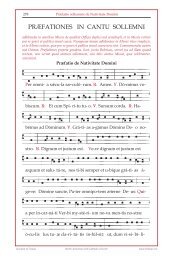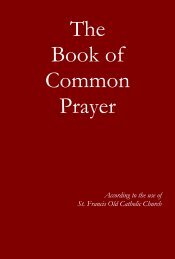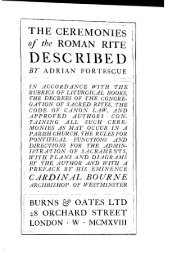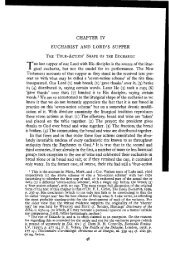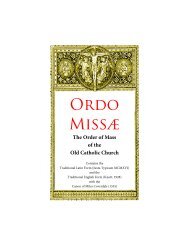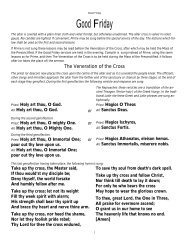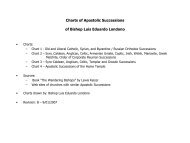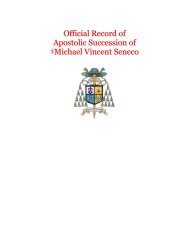The Shape of the Liturgy; Chapter III
The Shape of the Liturgy; Chapter III
The Shape of the Liturgy; Chapter III
Create successful ePaper yourself
Turn your PDF publications into a flip-book with our unique Google optimized e-Paper software.
THE SHAPE OF THE LITURGY<br />
for granted. <strong>The</strong>n and now its result upon <strong>the</strong> devout laity is to provoke an<br />
excessivelyindividualistic conception <strong>of</strong> personal prayer.<br />
By <strong>the</strong> middle <strong>of</strong> <strong>the</strong> fourth century <strong>the</strong> universal use <strong>of</strong> this pre-Nicene<br />
method <strong>of</strong> corporate intercession was beginning to disappear, a process in<br />
which <strong>the</strong> Antiochene invention <strong>of</strong> <strong>the</strong> 'Litany' form played an undesigned<br />
part (el. pp. 477 sqq.). Ano<strong>the</strong>r fourth century innovation, this time first<br />
attested in <strong>the</strong> church <strong>of</strong> Jerusalem, was<strong>the</strong> transference <strong>of</strong> <strong>the</strong> intercessions<br />
<strong>the</strong>mselves from <strong>the</strong> old position after <strong>the</strong> sermon to a point within <strong>the</strong><br />
eucharistic prayer, a change which o<strong>the</strong>r churches imitated in various<br />
different ways. <strong>The</strong> resulting duplication <strong>of</strong> <strong>the</strong> intercessions in some rites<br />
and <strong>the</strong>ir shifting in o<strong>the</strong>rs is <strong>the</strong> first serious complication <strong>of</strong> <strong>the</strong> old clear<br />
universal <strong>Shape</strong> <strong>of</strong> <strong>the</strong> <strong>Liturgy</strong>.<br />
But before <strong>the</strong>se fourth century Syrian innovations <strong>the</strong> synaxis everywhere<br />
ended with <strong>the</strong> intercessions <strong>of</strong>fered in <strong>the</strong> way we have described.<br />
If<strong>the</strong> eucharist were not to follow, <strong>the</strong> congregation dispersed, ei<strong>the</strong>r with<br />
a dismissal by <strong>the</strong> deacon or, in some fourth century churches, with a<br />
blessing by <strong>the</strong> bishop.<br />
When <strong>the</strong> eucharist did follow <strong>the</strong> synaxis, <strong>the</strong>se intercessory 'prayers<br />
<strong>of</strong> <strong>the</strong> faithful', as <strong>the</strong>y came to be called, though part <strong>of</strong> <strong>the</strong> synaxis, were<br />
attended exclusively by those who were about to be present at <strong>the</strong> eucharist.<br />
<strong>The</strong> catechumens and enquirers who had been present at <strong>the</strong> lections<br />
and sermon were dismissed before <strong>the</strong> prayers began. <strong>The</strong> intercessions<br />
thus came to be regarded ra<strong>the</strong>r as <strong>the</strong> opening devotion <strong>of</strong> <strong>the</strong> eucharist than<br />
as <strong>the</strong> conclusion <strong>of</strong> <strong>the</strong> synaxis. When <strong>the</strong> misleading names 'mass <strong>of</strong> <strong>the</strong><br />
catechumens' for <strong>the</strong> synaxis, and 'mass <strong>of</strong> <strong>the</strong> faithful' for <strong>the</strong> eucharist,<br />
began to be attached to <strong>the</strong> two parts <strong>of</strong> what had now been fused into a<br />
single rite, <strong>the</strong> 'prayers <strong>of</strong> <strong>the</strong> faithful' were by a natural mistake included<br />
in <strong>the</strong> latter. But <strong>the</strong> earlier evidence is clear enough that <strong>the</strong>y were originally<br />
<strong>the</strong> conclusion <strong>of</strong> <strong>the</strong> synaxis and not <strong>the</strong> beginning <strong>of</strong> <strong>the</strong> eucharist.<br />
Everywhere <strong>the</strong> synaxis celebrated apart from <strong>the</strong> eucharist ended with<br />
<strong>the</strong>se prayers, as did <strong>the</strong> evening synaxis (corresponding to evening prayer<br />
or vespers) when this was first instituted as a public service, probably in<br />
<strong>the</strong> fourth century. <strong>The</strong> eucharist when celebrated alone normally began<br />
with <strong>the</strong> <strong>of</strong>fertory.! It is as part <strong>of</strong> <strong>the</strong> synaxis and not as <strong>the</strong> beginning <strong>of</strong> <strong>the</strong><br />
1 <strong>The</strong> exception in pre-Nicene times was <strong>the</strong> baptismal eucharist, at which both<br />
Justin (Ap., i. 65) and Hippolytus (Ap. Trad., xxii. 5) interpose <strong>the</strong>se prayers between<br />
<strong>the</strong> initiation <strong>of</strong> <strong>the</strong> new christians by baptism and confirmation and <strong>the</strong> <strong>of</strong>fertory<br />
<strong>of</strong> <strong>the</strong> eucharist at which <strong>the</strong>y forthwith made <strong>the</strong>ir first communion. This was a<br />
special case <strong>of</strong> which <strong>the</strong> purpose seems to have been to allow <strong>the</strong> neophyte to discharge<br />
at once all <strong>the</strong> functions and enjoy all <strong>the</strong> privileges <strong>of</strong> <strong>the</strong> 'order <strong>of</strong> laity',<br />
into which he had just been admitted. <strong>The</strong> special restrictions on <strong>the</strong> catechumen<br />
took three forms: he might never receive <strong>the</strong> kiss <strong>of</strong> peace from <strong>the</strong> faithful; he<br />
might not pray with <strong>the</strong> faithful; he might not eat with <strong>the</strong> faithful. (<strong>The</strong>y are<br />
derived, <strong>of</strong> course, from <strong>the</strong> jewish restrictions on domestic intercoUrse with non<br />
Israelites, which were <strong>the</strong> same.) <strong>The</strong> catechumen receives <strong>the</strong> kiss <strong>of</strong> peace from<br />
<strong>the</strong> bishop immediately after receiving <strong>the</strong> chrism <strong>of</strong> confirmation, which conveyed<br />
<strong>the</strong> gift <strong>of</strong> <strong>the</strong> Spirit; he forthwith prays with <strong>the</strong> church in <strong>the</strong> intercessions, exer-



